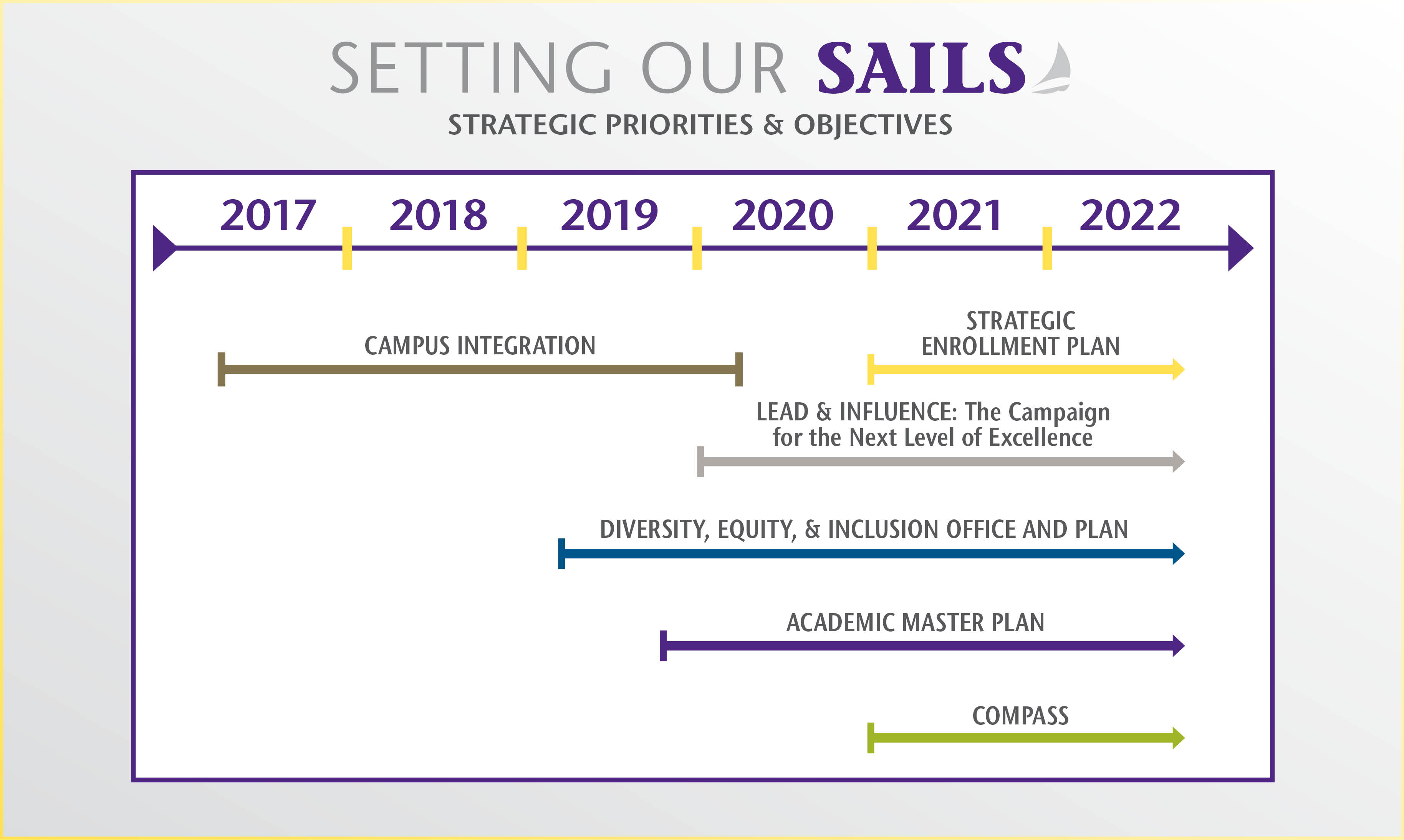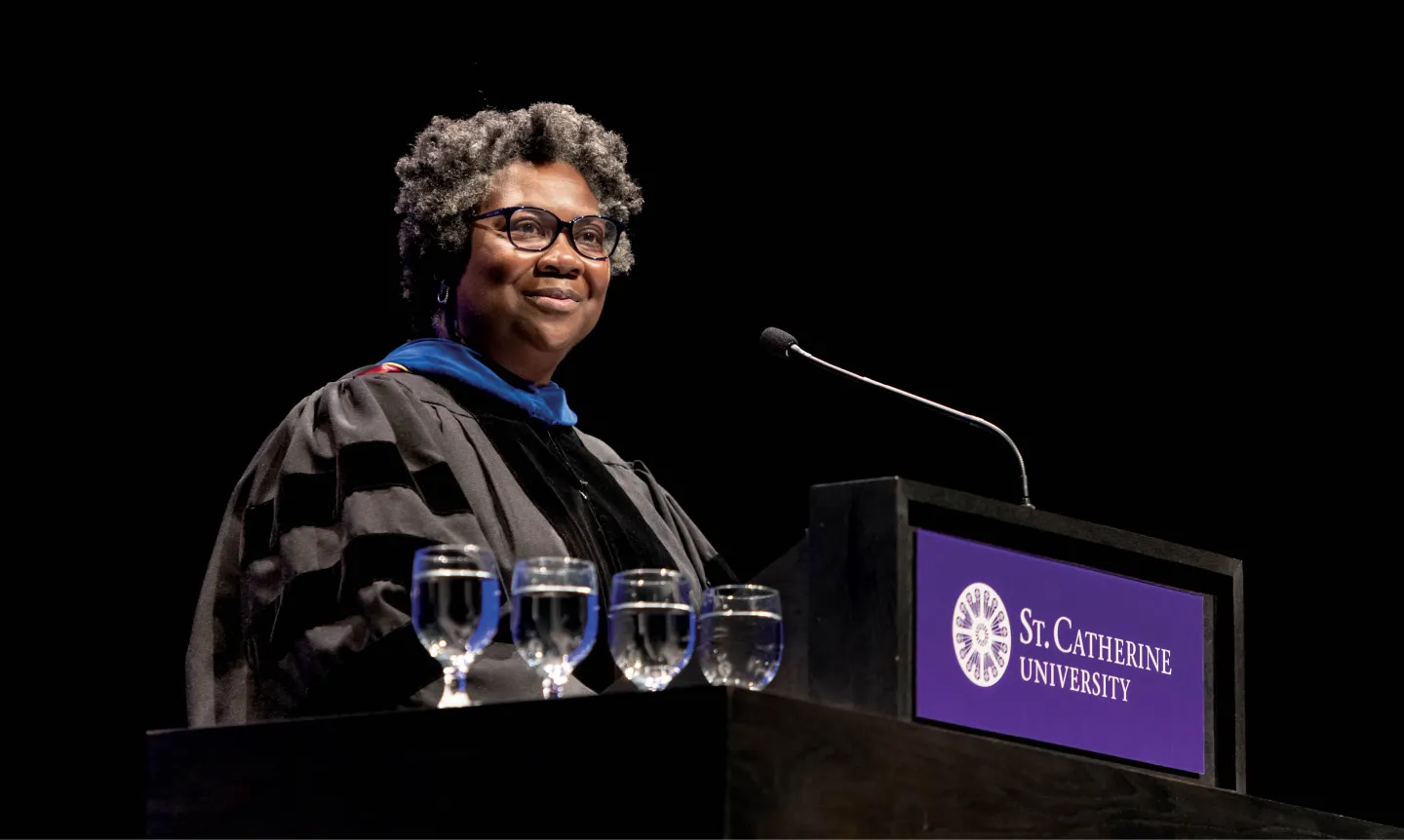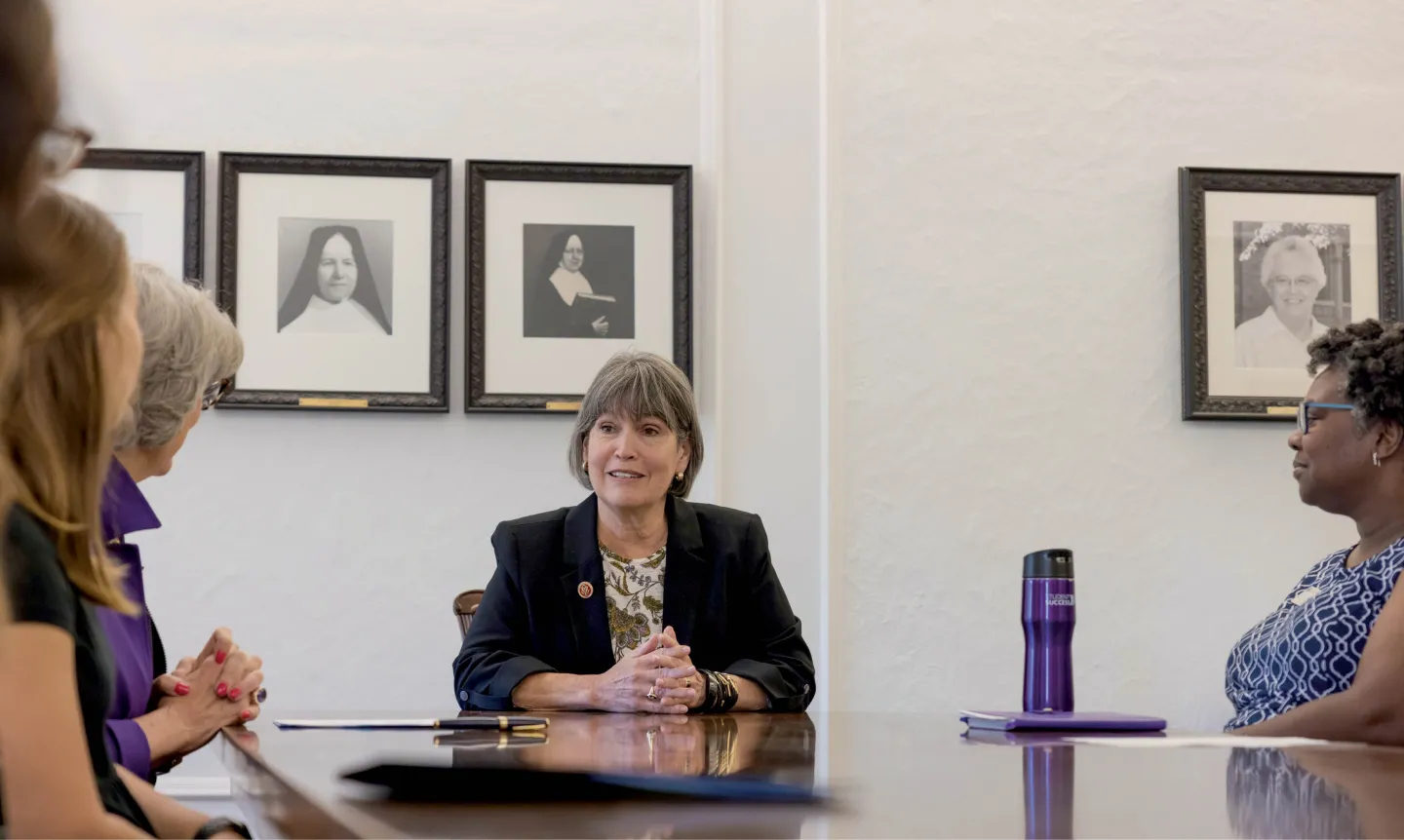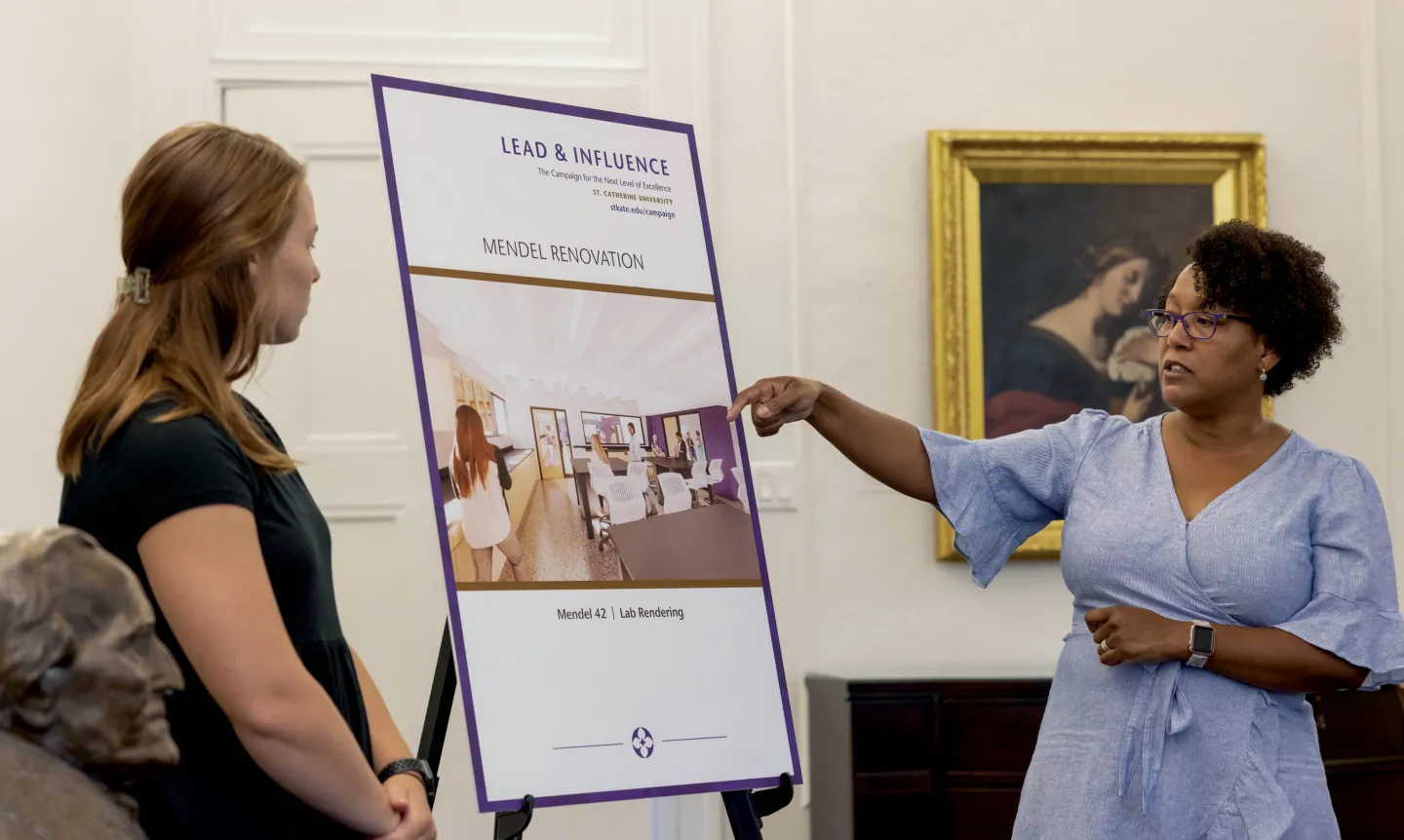By Melissa Neil, from St. Catherine University Magazine fall 2022 issue.
A look through the history of St. Catherine University shows deep commitment to challenging social norms, shaped by the clarion call of the Sisters of St. Joseph of Cardondelet (CSJs) to love God and neighbor without distinction and to do all of which women are capable. When the Sisters opened St. Mary’s Hospital School in 1900 and began educating the first cohort of future nurses, women’s postsecondary education was more of a closed door than a glass ceiling — it was simply not necessary. Yet the CSJs, in their prescient and audacious vision, knew it was.
These moments of challenging the so-called wisdom of the day, in favor of meeting needs of the time, emerge again and again throughout the timeline of the University: proof of St. Kate’s adaptability and advocacy for women’s leadership.

Shaping the Future
In 2017, when the CSJs gifted the physical Minneapolis campus — land they owned for 130 years — to St. Catherine University, they began an integration into “One University.” They also furthered the foundational CSJ tradition of community connections; with the Sisters’ blessing, the University sold the Minneapolis campus to long-time neighbor and healthcare partner, Fairview Health Services. This pivotal generosity set in motion a plan to thoughtfully and strategically continue the legacy of the Sisters while making quick strides to improve equity for women.The Setting Our Sails strategic plan of 2018 was born, and St. Catherine University committed to accomplishing six strategic priorities over the next 10 years:
- Strengthen Academic Excellence
- Stake Our Claim
- Forge Partnerships
- Foster Forever St. Catherine
- Drive a Culture of Inclusive Excellence
- Build a Strong & Sustainable Foundation
Now in the plan’s fifth year, St. Kate’s celebrates the remarkable accomplishments of this halfway mark and continues to shape our proactive plan for an enduring future. Today brings new challenges, but St. Catherine University remains on the forefront of navigating change and emboldening women to lead, influence, and pursue lives of purpose.
At the Heart: Students
Students, the center of all we do, continue to face considerable challenges to their success. Since 2010, college enrollment has declined 9.6% nationwide and 15% across Minnesota. Additionally, 24.1% of first-time undergraduates drop out within 12 months of beginning college, and traditionally underserved populations have an even higher dropout rate. In the face of these trends, and as part of the University’s work to Stake Our Claim, the Board of Trustees approved the Strategic Enrollment Plan in October 2021.
The plan focuses on adjusting marketing approaches to align with how prospective students consume information, but also on optimizing financial aid and funding, meeting the changing needs of programming, and creating pipelines of new students. At a time when enrollment is down significantly nationwide and there is ongoing debate about the value of higher education, numbers at St. Kate’s are encouraging. New student enrollment in the College for Adults is up 19% this year compared to fall 2021, and first-time enrollment in the College for Women increased by 6%. Retention of students from their first year into their second year is up nearly 7%.

An Integrated Approach
Foundational to the Strategic Enrollment Plan are initiatives housed within two other priorities, Strengthen Academic Excellence and Drive a Culture of Inclusive Excellence. As a university, St. Kate’s is naturally focused on creating opportunities for students to pursue a degree and coursework, positioning them to enter an ever-evolving job market after graduation. The Academic Master Plan, developed in 2020, includes a blueprint for a re-envisioned program array that holds true to the University’s commitment to community, social justice, and leadership while enriching opportunities for career advancement. What makes St. Kate’s unique is the recognition that retention and lifelong fulfillment are influenced by a sense of belonging, a strong support network, opportunities to pursue meaningful experiences, and more.

Anita Thomas, PhD, executive vice president and provost
“Improving graduation rates is our long-term goal,” says Anita Thomas, PhD, executive vice president and provost. “But we need to understand what helps students stay and persist in education. We not only look at curricular offerings, but also what students are participating in that’s cocurricular or extracurricular and why.”
The University’s Academic Master Plan has advanced this work by outlining the role of the newly created Office of Scholarly Engagement (OSE) and setting a framework for COMPASS. OSE infuses high-impact practices into student learning experiences at all degree levels, and identifies and reduces barriers to participation. COMPASS integrates a support network— across curriculum, community work, career development, and more — that intentionally and reflectively aligns students’ experiences within and outside the classroom, providing a road map of sorts as Katies choose curricular and cocurricular activities.
COMPASS rolled out last fall with first-year undergraduate students. As these students enter their second year, there’s added emphasis on a meaningful life that includes a spiritual retreat on and off campus. Mentorship also holds more weight, and new tools launching this school year will support growing these connections.
A Step Further: The Purple Thread
Research clearly shows that students who feel like they belong in school are more likely to experience positive educational and developmental outcomes. And belonging is more than being part of a group. It’s tied tightly to identity, an emphasis on inclusive excellence that becomes the “purple thread” woven through all St. Kate’s strategic priorities.
St. Kate’s history is rich with examples of striving for equity for marginalized populations. Throughout the 1900s, the CSJs faced challenges educating women in a patriarchal and sexist society; preserving Catholicism in a Protestant-dominant, anti-Catholic society in the 1920s and 1930s; serving immigrants and the working class in a time of pronounced xenophobia and class oppression; and addressing social and economic injustices through academic experience. The last decades of the 20th century and the first of the 21st have enriched the definition of social justice even further to include more aspects of diversity.
Building on this legacy, the University solidified its commitment to inclusive excellence in 2021 with the Inclusive Excellence Strategic Plan. This plan advances the idea that diversity, equity, and inclusion — “the purple thread” — are catalysts and vital elements for achieving institutional and educational excellence within the context of a women-centered institution.
The plan’s strategic priorities were developed with the engagement of 200 community members, and focus on pursuing the necessary infrastructure, awareness, and expertise to support the University as it strives to become an anti-racist and inclusive institution.
“We as an institution are challenged with the same issues prevalent in our broader community,” says Pat Pratt-Cook, senior vice president for human resources, equity, and inclusion. “This work is not a destination, it’s a journey. Our goal is to continue evolving and to get better by proactively looking at what we need to address systemically.”
Since the Inclusive Excellence Strategic Plan’s inception, Pratt-Cook and Sandra Mitchell, director of equity and inclusion, have focused much of their time on creating professional development opportunities. The knowledge and experiences gained by faculty and staff determine the overall success of students, from academic to inclusive excellence.
For example, trainings highlight teaching approaches that encourage knowledge of self and others, empathy and curiosity, and verbal and nonverbal communication skills around issues of inclusive excellence. Mitchell, Pratt- Cook, and their team and collaborators have fulfilled many plan objectives, including a University statement on inclusive excellence and a land acknowledgment statement recognizing the Dakota people.
Engaging, Involving, Supporting
Alumni-student connection is a rich source of support and opportunity for graduating Katies. “It’s not only about who you know,” says May Thao-Schuck, vice president of career and professional development, “but about who knows you when pursuing a career or first job outside of college.”
In support of this and of fostering the Katie connection, the University is advancing the Forever St. Catherine line of the Setting Our Sails strategic plan with exciting, more diverse ways for alumni of all three colleges to engage. A new approach creates programs for alumni that are relevant, accessible, and span all colleges within the University. Alums now have access to one-time, short-term, and ongoing opportunities to volunteer, and programming is involving more and more community members.

This spring, Congresswoman Betty McCollum '87 secured $800,000 of federal funding for renovations to Mendel, the University's historic science building.
“With the possibilities provided by virtual and hybrid events, in addition to our traditional in-person, we’re now able to invite Katies across the country to alumni programming, not only those in the metro area,” says Beth Riedel Carney ’82, vice president of development and alumni relations. “And now, with the Forever St. Catherine Tour, we’re traveling with University leadership across the country to share more about what’s happening with St. Kate’s today with our extended community of alums, parents, friends, prospective students, and more.”
Partnerships with the broader community are equally as important as alum engagement. Thao-Schuck is working with employers to keep a pulse on job growth trends and prepare students for careers of the future. To date, more than 600 business partners are available to Katies for internships, fieldwork, and clinical trials. Thao-Schuck also continues her work mapping out how the skills used in declining industries can transfer to areas where jobs are growing: education, healthcare, manufacturing, and technology.
This year the University entered into a partnership with Fontbonne University. Initially, Fontbonne will use space on the St. Kate’s campus to deliver its programming, and in the future St. Kate’s will do the same at Fontbonne. The partnership at once expands St. Kate’s presence outside of Minnesota and also expands financial resources to support other University initiatives.
A Campaign for the Future
St. Kate’s could not make and continue our great strides without financial resources and a clear vision for those resources that integrates strategic initiatives. In 2013, prior to the Setting Our Sails strategic plan, the University embarked on LEAD & INFLUENCE: The Campaign for the Next Level of Excellence to raise $130 million. The strategic plan gave structure to the campaign and a renewed focus on students, faculty, place, and the Katie Fund. While the campaign concludes in November 2023, as of August 2022 it just reached more than $120 million in contributions from over 15,000 donors. Work is already underway to renovate the Mendel building to diversify the future of STEM, preserve the historic Our Lady of Victory Chapel, expand need-based financial aid, and fulfill commitments that accomplish the goals of the Setting Our Sails strategic plan.
“We could not be more grateful to the alumni, staff and faculty, students, University partners, and friends who help build a culture of philanthropy at St. Kate’s,” says Joanne Jirik Mullen ’83, co-chair of the Campaign Cabinet.

Taviare Hawkins, PhD, division chair for math and sciences, presents the vision for enhanced facilities and student development in Lead & Influence: The Campaign for the Next Level of Excellence.
The Infrastructure: A Stable Foundation
What often goes unnoticed is the work behind the scenes to make plans come to life and the campus experience flow smoothly. When senior vice president and chief information officer Jean Guezmir joined St. Kate’s, she and her team were poised to create a more modern technology infrastructure. Now, every time someone uses a meeting room, classroom, or lab, or connects to an application, makes a phone call, prints a document, receives IT support, or engages with the website, they are using all-new modernized capabilities.
Students are better supported with resources such as check-out equipment and COMPASS applications, and faculty are better supported with an updated course management platform and standardized high-flex classrooms and labs. With these foundations established, Guezmir is partnering with the leadership team on building the Student Success application and improving operational processes for students and staff efficiencies.
What's next?
St. Kate’s embarks on the last five years of the Setting Our Sails strategic plan with an even greater commitment to data that helps our teams understand the impact of their work, fulfill current plans, and develop the next iteration of plans to carry initiatives through 2028. Paired with this commitment to data informing the second half of the plan is commitment to academic excellence — student success and educational impact, through initiatives like COMPASS, to put even more wind in our sails to the Next Level of Excellence. In a tumultuous world, the University’s dedication to fulfilling the Setting Our Sails strategic plan has not wavered; though developed before COVID-19 and the seismic shifts the pandemic created in many areas of life, Setting Our Sails had already laid the foundation needed to move through change. In true St. Catherine fashion, the plan is equal parts adaptability and foresight.